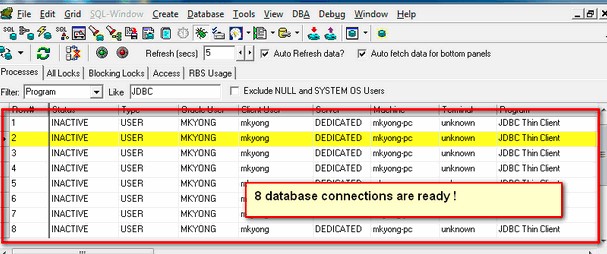更新时间:2022-09-13 08:57:23 来源:星辉 浏览588次
相信大家对什么是Hibernate已经有所了解,在本教程中,我们将向您展示如何将 Apache DBCP 连接池与 Hibernate 框架集成。
要将 DBCP 与 Hibernate 集成,您需要commons-dbcp.jar和commons-pool-1.5.4.jar。
文件:pom.xml
<project ...>
<repositories>
<repository>
<id>JBoss repository</id>
<url>http://repository.jboss.org/nexus/content/groups/public/</url>
</repository>
</repositories>
<dependencies>
<dependency>
<groupId>org.hibernate</groupId>
<artifactId>hibernate-core</artifactId>
<version>3.6.3.Final</version>
</dependency>
<dependency>
<groupId>commons-dbcp</groupId>
<artifactId>commons-dbcp</artifactId>
<version>1.4</version>
</dependency>
</dependencies>
</project>
要将 DBCP 与 Hibernate 集成,您需要创建一个“ DBCPConnectionProvider ”类。
文件:DBCPConnectionProvider.java
package com.mkyong.util;
import java.io.PrintWriter;
import java.io.StringWriter;
import java.sql.Connection;
import java.sql.SQLException;
import java.util.Iterator;
import java.util.Map;
import java.util.Properties;
import org.apache.commons.dbcp.BasicDataSource;
import org.apache.commons.dbcp.BasicDataSourceFactory;
import org.hibernate.HibernateException;
import org.hibernate.cfg.Environment;
import org.hibernate.connection.ConnectionProvider;
import org.hibernate.connection.ConnectionProviderFactory;
import org.slf4j.Logger;
import org.slf4j.LoggerFactory;
public class DBCPConnectionProvider implements ConnectionProvider {
private static final Logger log = LoggerFactory
.getLogger(DBCPConnectionProvider.class);
private static final String PREFIX = "hibernate.dbcp.";
private BasicDataSource ds;
// Old Environment property for backward-compatibility (property removed in
// Hibernate3)
private static final String DBCP_PS_MAXACTIVE = "hibernate.dbcp.ps.maxActive";
// Property doesn't exists in Hibernate2
private static final String AUTOCOMMIT = "hibernate.connection.autocommit";
public void configure(Properties props) throws HibernateException {
try {
log.debug("Configure DBCPConnectionProvider");
// DBCP properties used to create the BasicDataSource
Properties dbcpProperties = new Properties();
// DriverClass & url
String jdbcDriverClass = props.getProperty(Environment.DRIVER);
String jdbcUrl = props.getProperty(Environment.URL);
dbcpProperties.put("driverClassName", jdbcDriverClass);
dbcpProperties.put("url", jdbcUrl);
// Username / password
String username = props.getProperty(Environment.USER);
String password = props.getProperty(Environment.PASS);
dbcpProperties.put("username", username);
dbcpProperties.put("password", password);
// Isolation level
String isolationLevel = props.getProperty(Environment.ISOLATION);
if ((isolationLevel != null)
&& (isolationLevel.trim().length() > 0)) {
dbcpProperties.put("defaultTransactionIsolation",
isolationLevel);
}
// Turn off autocommit (unless autocommit property is set)
String autocommit = props.getProperty(AUTOCOMMIT);
if ((autocommit != null) && (autocommit.trim().length() > 0)) {
dbcpProperties.put("defaultAutoCommit", autocommit);
} else {
dbcpProperties.put("defaultAutoCommit",
String.valueOf(Boolean.FALSE));
}
// Pool size
String poolSize = props.getProperty(Environment.POOL_SIZE);
if ((poolSize != null) && (poolSize.trim().length() > 0)
&& (Integer.parseInt(poolSize) > 0)) {
dbcpProperties.put("maxActive", poolSize);
}
// Copy all "driver" properties into "connectionProperties"
Properties driverProps = ConnectionProviderFactory
.getConnectionProperties(props);
if (driverProps.size() > 0) {
StringBuffer connectionProperties = new StringBuffer();
for (Iterator iter = driverProps.entrySet().iterator(); iter
.hasNext();) {
Map.Entry entry = (Map.Entry) iter.next();
String key = (String) entry.getKey();
String value = (String) entry.getValue();
connectionProperties.append(key).append('=').append(value);
if (iter.hasNext()) {
connectionProperties.append(';');
}
}
dbcpProperties.put("connectionProperties",
connectionProperties.toString());
}
// Copy all DBCP properties removing the prefix
for (Iterator iter = props.entrySet().iterator(); iter.hasNext();) {
Map.Entry entry = (Map.Entry) iter.next();
String key = (String) entry.getKey();
if (key.startsWith(PREFIX)) {
String property = key.substring(PREFIX.length());
String value = (String) entry.getValue();
dbcpProperties.put(property, value);
}
}
// Backward-compatibility
if (props.getProperty(DBCP_PS_MAXACTIVE) != null) {
dbcpProperties.put("poolPreparedStatements",
String.valueOf(Boolean.TRUE));
dbcpProperties.put("maxOpenPreparedStatements",
props.getProperty(DBCP_PS_MAXACTIVE));
}
// Some debug info
if (log.isDebugEnabled()) {
StringWriter sw = new StringWriter();
dbcpProperties.list(new PrintWriter(sw, true));
log.debug(sw.toString());
}
// Let the factory create the pool
ds = (BasicDataSource) BasicDataSourceFactory
.createDataSource(dbcpProperties);
// The BasicDataSource has lazy initialization
// borrowing a connection will start the DataSource
// and make sure it is configured correctly.
Connection conn = ds.getConnection();
conn.close();
// Log pool statistics before continuing.
logStatistics();
} catch (Exception e) {
String message = "Could not create a DBCP pool";
log.error(message, e);
if (ds != null) {
try {
ds.close();
} catch (Exception e2) {
// ignore
}
ds = null;
}
throw new HibernateException(message, e);
}
log.debug("Configure DBCPConnectionProvider complete");
}
public Connection getConnection() throws SQLException {
Connection conn = null;
try {
conn = ds.getConnection();
} finally {
logStatistics();
}
return conn;
}
public void closeConnection(Connection conn) throws SQLException {
try {
conn.close();
} finally {
logStatistics();
}
}
public void close() throws HibernateException {
log.debug("Close DBCPConnectionProvider");
logStatistics();
try {
if (ds != null) {
ds.close();
ds = null;
} else {
log.warn("Cannot close DBCP pool (not initialized)");
}
} catch (Exception e) {
throw new HibernateException("Could not close DBCP pool", e);
}
log.debug("Close DBCPConnectionProvider complete");
}
protected void logStatistics() {
if (log.isInfoEnabled()) {
log.info("active: " + ds.getNumActive() + " (max: "
+ ds.getMaxActive() + ") " + "idle: " + ds.getNumIdle()
+ "(max: " + ds.getMaxIdle() + ")");
}
}
public boolean supportsAggressiveRelease() {
return false;
}
}
现在,链接您的“ DBCPConnectionProvider ”并在“ hibernate.cfg.xml ”中定义 DBCP 属性,例如:
文件:hibernate.cfg.xml
<?xml version="1.0" encoding="utf-8"?>
<!DOCTYPE hibernate-configuration PUBLIC
"-//Hibernate/Hibernate Configuration DTD 3.0//EN"
"http://hibernate.sourceforge.net/hibernate-configuration-3.0.dtd">
<hibernate-configuration>
<session-factory>
<property name="hibernate.connection.driver_class">oracle.jdbc.driver.OracleDriver</property>
<property name="hibernate.connection.url">jdbc:oracle:thin:@localhost:1521:MKYONG</property>
<property name="hibernate.connection.username">mkyong</property>
<property name="hibernate.connection.password">password</property>
<property name="hibernate.dialect">org.hibernate.dialect.Oracle10gDialect</property>
<property name="hibernate.default_schema">MKYONG</property>
<property name="show_sql">true</property>
<property name="hibernate.connection.provider_class">
com.mkyong.util.DBCPConnectionProvider
</property>
<property name="hibernate.dbcp.initialSize">8</property>
<property name="hibernate.dbcp.maxActive">20</property>
<property name="hibernate.dbcp.maxIdle">20</property>
<property name="hibernate.dbcp.minIdle">0</property>
<mapping class="com.mkyong.user.DBUser"></mapping>
</session-factory>
</hibernate-configuration>
完成,运行它并查看以下输出:

在应用程序启动阶段,连接池中创建了 8 个数据库连接,供您的 Web 应用程序使用。如果大家想了解更多相关知识,可以关注一下星辉的Hibernate入门视频,课程内容由浅到深,通俗易懂,适合小白学习。
 Java实验班
Java实验班
0基础 0学费 15天面授
 Java就业班
Java就业班
有基础 直达就业
 Java夜校直播班
Java夜校直播班
业余时间 高薪转行
 Java在职加薪班
Java在职加薪班
工作1~3年,加薪神器
 Java架构师班
Java架构师班
工作3~5年,晋升架构
提交申请后,顾问老师会电话与您沟通安排学习